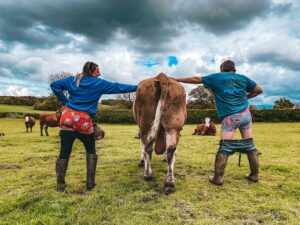 Organic manures have a huge potential to provide farmers with a cheap fertiliser that can help improve soil and cut back on costs, but getting the application right is important.
Organic manures have a huge potential to provide farmers with a cheap fertiliser that can help improve soil and cut back on costs, but getting the application right is important.
To help farmers make the most of their slurry and muck, a wide range of industry experts will be on hand at Grassland UK, along with the latest equipment and machinery to make the job as efficient as possible.
Spreading manures should not just be using up a by-product, but about fully utilising a valuable resource, says head of show, Alan Lyons. “Nutrient levels vary considerably, as do the application technology and regulations, so there’s more to this simple practice than just spreading it on the field. The key is to maximise nutrient availability by applying manure in optimum conditions, and thereby reduce the need for inorganic inputs.”
Matching manure applications to the soil nutrient status is crucial, advises John Williams at ADAS, who will be speaking in the muck demonstration area and seminars. “Muck and slurry should be used and treated as a fertiliser, rather than a waste product. It does take investment in kit and management to do it well but it’s a wonderfully valuable source of nutrients.”
Every 40t/ha of cattle farm yard manure can be worth £220/ha in NPK value, he explains.
The first thing is to understand the nutrient content of the material. “Manures have variable nutrient content and dry matter levels – and cattle slurry will typically have different nutrient content to pig slurry reflecting differences in feed and slurry management. The AHDB Nutrient Management Guide has averages for a number of organic manures and these typical figures are a good starting point,” says Mr Williams “Taking samples is the next step and it’s important to take representative samples. Try to homogenise the slurry in some way and take a number of samples during store emptying to see how the content varies.”
Farmers then have to decide where to apply the muck. “With a typical application you will often be supplying more phosphate and potash than the crop will need in one year, so repeat applications can lead to elevated levels in soil,” he explains. “Therefore soil testing first can identify where best to put the manure.”
Application rates should be tailored to meet the crop’s nutrient demands. “This is reasonably straightforward for slurry as you’ll know what the tanker holds and the size of the field but it’s more difficult with solid materials as the bulk density and weight can vary – and newer material will take up more space than old.”
One way to approach application rates is to use a spreader which has weigh cells, but alternatively a weigh bridge can be used. “If you apply without knowing the weight of manure in the spreader, then you can’t know what the application rate is.”
Mr Williams also suggests making sure slurry and muck are spread as evenly as possible and that solids are incorporated within 24 hours to minimise smells and reduce nutrient losses. “Spring applications are better for nitrogen use efficiencies but you’ve got to be careful not to damage the soil. Also, the risk of run off and contamination is higher – so it’s important to get timings right. In the autumn soils are typically drier and applications are best done in September or October to crops that require autumn N, such as grass or oilseed rape – otherwise you risk leaching.”
Visitors will be able to see a large range of exhibitors at Grassland UK, enabling them to get the best advice on what is needed for their system. Whether you are looking for a new spreader, variable rate technology or more information on how to test manures and soils, there’ll be an opportunity to get questions answered or to see the latest kit demonstrated.
- Grassland UK 2018 takes place on Bridge Farm & Bagborough Farm, adjacent to the Bath & West Showground on Thursday 10 May from 9am to 4pm. Tickets cost £17 (£15 for students) in advance or £20 on the gate. For more information and to book tickets head to bathandwest.com.
Attendance at Grassland UK will attract 2 BASIS CPD points for those who register their attendance. The register will be located in the seminars marquee in the trade stand field.



